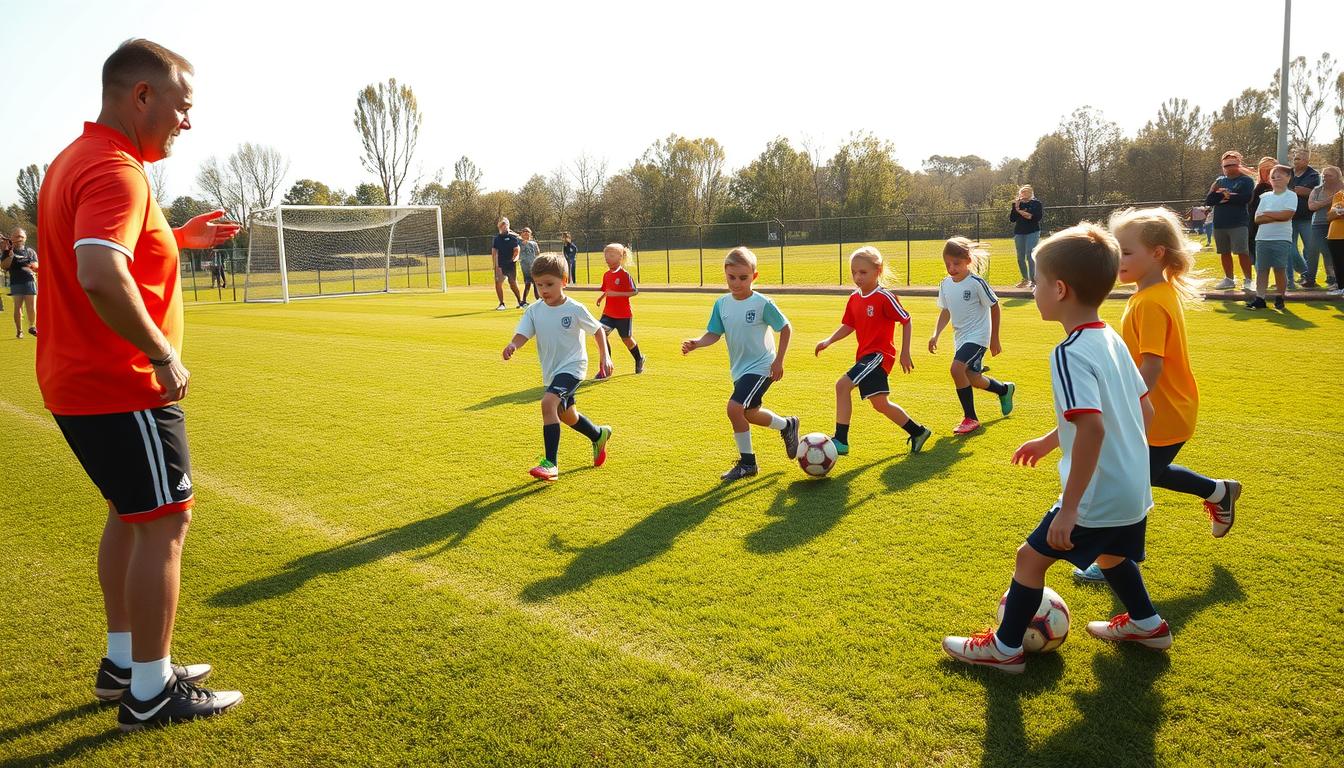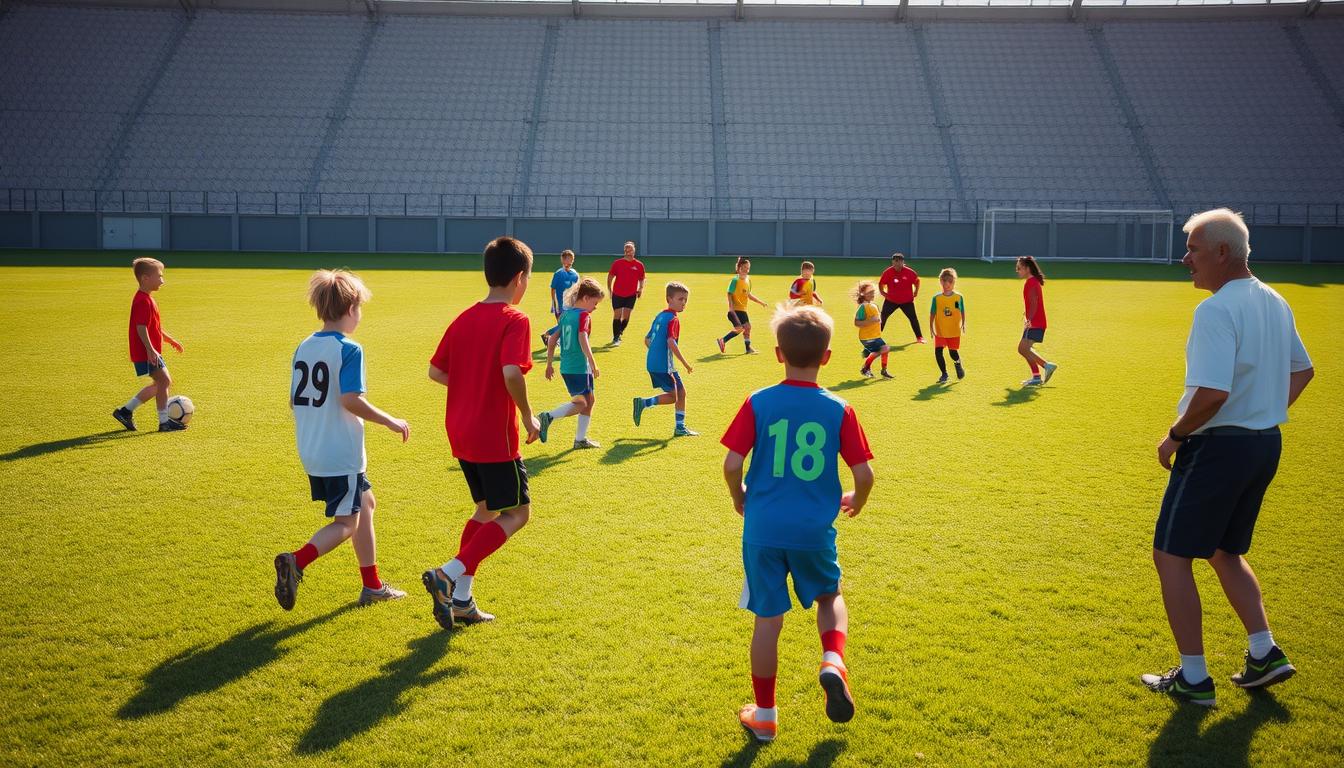Beginner Soccer Tips for Kids

Is your child ready to discover the joy of sports? Youth soccer offers a perfect blend of exercise, skill-building, and teamwork that grows with young athletes. Through FIFA-approved modifications like smaller fields and lighter balls, this sport becomes accessible even for preschoolers as young as 2-3 years old.
This guide simplifies the game’s fundamentals into bite-sized lessons that build coordination and confidence. You’ll learn how to transform complex rules into fun activities that keep kids engaged. Best of all, every practice session becomes an opportunity to nurture social skills and lifelong healthy habits.
Key Takeaways
- Modified rules make soccer adaptable for different age groups
- Early exposure builds motor skills and social development
- Age-appropriate equipment enhances safety and enjoyment
- Short practice sessions maximize focus and progress
- Positive reinforcement boosts confidence in new players
Understanding the Basics of Soccer for Young Players
Mastering soccer fundamentals starts with age-friendly adjustments that keep the game exciting and achievable. Youth leagues adapt professional rules to match children’s physical abilities and learning styles, creating a supportive environment for skill growth.
Simplifying Soccer Rules and Game Objectives
The core mission remains straightforward: move the ball into the opposing team’s goal. For younger players, referees often skip complex penalties like offside calls. Coaches might allow unlimited substitutions or shorter quarters to maintain energy levels.
How Field and Ball Sizes Affect Play
Smaller fields prevent exhaustion while encouraging frequent touches. A U5 match might use a 20×30 yard space instead of full-sized pitches. Ball dimensions also scale down:
- Size 3 (18″ circumference) for ages 3-5
- Size 4 (25″) for 6-12 year-olds
- Size 5 (27″) for teens and adults
Team formats shrink proportionally too. While professional matches use 11 players per side, kindergarten leagues often play 4v4. These changes let every child stay involved in the action rather than chasing the ball across large areas.
Beginner soccer tips for kids: Getting Started with the Game
Developing essential abilities in young athletes begins with age-appropriate challenges. Focus on four foundational techniques that create confident participation. These methods help children build coordination while keeping sessions enjoyable.
Introducing Fundamental Soccer Skills
Start with dribbling using lightweight size 3 balls. Preschoolers learn control by guiding the ball with gentle taps. Progress to passing once they move confidently.
| Skill | Age Focus | Key Equipment |
|---|---|---|
| Dribbling | 2-5 years | 12-oz size 3 ball |
| Passing | 4-6 years | Cones for targets |
| Shooting | 5+ years | Smaller goals |
Ball control means stopping passes smoothly. Use soft throws at first, then increase speed. Celebrate when they trap the ball with feet or torso.
Exploring the Role of Coaches and Parents
Coaches structure team lessons around skill-building games. Parents reinforce these training basics through backyard play. Together, they create consistent learning.
Keep home practice short – 10-minute sessions work best. Praise effort over perfection. This teamwork helps children connect field activities with family time.
Fun Soccer Skills and Drills for Building Confidence
Help young athletes shine by turning fundamental techniques into achievable victories. These engaging exercises develop precision while keeping energy levels high. Focus on movements that blend technical growth with laughter-filled challenges.
Dribbling and Passing Techniques
Control the ball like a pro using quick, light touches. Teach players to guide the ball with both feet while keeping it within arm’s reach. Start with simple zig-zag patterns between cones before advancing to partner drills.
| Drill | Focus | Pro Tip |
|---|---|---|
| Red Light/Green Light | Ball Control | Freeze when coach shouts “red light” |
| Passing Squares | Accuracy | Use inside foot for soft rolls |
| Obstacle Course | Footwork | Keep head up while navigating |
For passing practice, create target zones using hula hoops. Celebrate when the ball lands inside! This builds spatial awareness and teamwork.
Kicking and Shooting Practice
Master different shot types through creative challenges. Use the inside base of the foot for powerful ground shots. Lean slightly forward when striking through the center of the ball.
Try these scoring exercises:
- Place colored cones in each corner of the goal
- Call out colors for players to aim at
- Rotate shooting distances weekly
For curve kicks, strike near the toes while brushing across the ball’s side. Chipping works best when contacting under the soccer ball with the big toe area. Keep sessions short but frequent – 15 minutes daily beats hour-long marathons!
Learning to Play as a Team and Practice Sportsmanship
Building strong team dynamics transforms individual skills into game-changing collaboration. Young players often swarm around the ball instinctively, but structured activities help them recognize teammates and space. This growth phase lays the foundation for strategic thinking and mutual support.

Encouraging Team Play and Communication
Kids initially focus on the ball like magnets, but simple adjustments create awareness. Try the “Attack” drill: divide into two teams and award points only for passes leading to goals. Players quickly learn that sharing creates better scoring chances.
- Practice calling teammates’ names when open
- Rotate positions to understand different roles
- Use high-fives after successful passes
Simple Exercises for Building Confidence
Develop defensive awareness through “Space Guard” games. Mark zones with cones and challenge players to protect their area while tracking opponents. This teaches spatial judgment without overwhelming rules.
Try these confidence-boosters:
- Partner passing relays with timed challenges
- Celebration circles after team achievements
- Positive phrase exchanges (“Great try!”) during water breaks
Cooperation-focused games reduce pressure while reinforcing that every player contributes. When kids cheer each other’s successes, they build bonds that outlast any scoreboard.
Soccer Equipment and Field Setup for Kids
Equipping young athletes properly transforms practice into skill-building adventures. The right tools and spaces let children focus on technique while staying safe. Let’s explore how to match gear and playing areas to growing abilities.
Choosing the Right Ball and Gear
Selecting properly sized equipment prevents strain and builds confidence. A ball that’s too heavy or large can hinder footwork development. Follow these guidelines for optimal performance:
| Age Group | Ball Size | Circumference | Weight | Essential Gear |
|---|---|---|---|---|
| 3-5 years | 3 | 22 inches | 12 oz | Shin guards, grip socks |
| 6-12 years | 4 | 25 inches | 14 oz | Molded cleats, moisture-wicking shirts |
| 12+ years | 5 | 27 inches | 16 oz | Ankle support, goalkeeper gloves |
Futsal-style balls (size 4 with reduced bounce) work well for backyard drills. Always pair footwear with playing surface – turf shoes for artificial grass, cleats for wet fields.
Establishing a Kid-Friendly Field Layout
Compact spaces boost engagement and technical growth. A 5v5 field measuring 30×20 yards creates frequent scoring chances. Use these elements to design practice zones:
- Cones spaced 5 yards apart for dribbling lanes
- 4×6 foot goals with safety nets
- Central circle marked with chalk or tape
Teach proper throw-ins using visual markers. Place two parallel lines 1 foot apart where players must keep both feet grounded. This builds muscle memory for game-ready techniques.
Age-Based Training: From Early Learners to Intermediate Players
Growing athletes thrive when training matches their physical and cognitive development. Tailored approaches help children build skills progressively while maintaining enthusiasm. Let’s explore how to adapt drills and expectations as young players mature.
Pre-School Methods for Getting Started
For 2-5 year-olds, focus on tactile experiences with lightweight equipment. Use size 3 balls that fit small hands and feet. Prioritize ball familiarity through gentle activities:
- Rolling exercises that develop tracking skills
- Obstacle courses with soft cones
- Partner games requiring gentle kicks
Celebrate every successful touch rather than perfect technique. Keep sessions under 15 minutes to match attention spans. This foundation prepares children for structured play later.
Elementary Drills for Skill Improvement
Six to twelve-year-olds gain coordination for multi-step challenges. Introduce size 4 balls and position-specific movements. Try these progression-focused activities:
| Age Group | Focus Area | Sample Drill |
|---|---|---|
| 6-8 years | Passing Accuracy | Triangle target practice |
| 9-10 years | Shooting Form | Moving goal challenges |
| 11-12 years | Positional Awareness | Small-sided strategy games |
Middle school athletes (grades 5-7) develop stamina for longer matches. Incorporate conditioning drills that mimic game scenarios. Shift focus to tactical decision-making during scrimmages.
Engaging Soccer Games and Interactive Drills
Transform practice sessions into laughter-filled learning moments with imaginative activities. These creative drills disguise skill-building as playful challenges, keeping energy high while developing technique. Young athletes thrive when games feel like adventures rather than drills.
Games That Enhance Dribbling and Passing
Boost ball mastery through these seven crowd-pleasers:
| Game | Skill Focus | Equipment Needed |
|---|---|---|
| Coach Target | Kicking Accuracy | 4 cones, 6 soft balls |
| Traffic Light Dribble | Speed Control | 10-yard space |
| Alien Defense | Goalie Basics | Hula hoop “spaceship” |
| Volcano Escape | Footwork Precision | 8-10 cone markers |
In Coach Target, players kick balls at a moving coach who reacts with silly animal impressions. Traffic Light Dribble teaches stop-and-go control using color commands. Alien Defense turns goalkeeping into a mission to protect a hula hoop “spaceship” from incoming balls.
For improving footwork, set up Volcano Escape. Kids weave through cones while avoiding “lava explosions” (knocked-over markers). Celebrate when they complete the course without eruptions!
Keep Away circles develop spatial awareness. Two defenders try to intercept passes between four attackers. Rotate roles so everyone practices both offense and defense. These activities build coordination while fostering teamwork.
Wrapping Up Your Soccer Journey for Young Players
Watching young athletes grow through sports creates lasting memories. Your child now carries essential soccer skills that blend technical ability with pure enjoyment. The magic lies in keeping the sport simple – no complex rules or pressure-packed drills.
Focus on letting kids explore the field freely. Coaches thrive when stepping back during games, allowing natural creativity to shine. This approach builds confidence as players experiment with moves learned through basic soccer lessons.
Remember: every practice session should feel like playtime. Celebrate moments when they touch ball successfully or laugh with teammates. These experiences form the foundation for lifelong love of the sport.
As your young athlete continues their journey, prioritize joy over competition. Whether they play soccer casually or pursue teams later, the skills learned now create endless possibilities. Keep the energy positive, and watch their passion grow!
